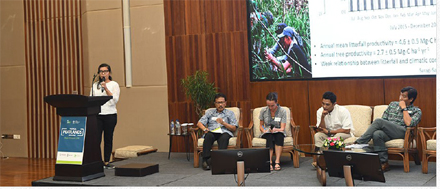
Found in more than 80 countries and covering only 3% of the world’s land but storing 30- 40% of soil carbons, tropical peatlands have the potential to play a large role in the future of climate change. Source: Timberbiz
The Center for International Forestry Research (CIFOR) with the support of the Government of Indonesia and the participation of the private sector organized a one-day event, the Tropical Peatlands Exchange, which served as a platform to update stakeholders and share information.
The Exchange opened with remarks from representatives of CIFOR, the Peatlands Restoration Agency (BRG) and the Research, Development and Innovation Agency of the Indonesian Ministry of Environment and Forestry (FOERDIA).
“Most important is to conserve whatever we can conserve now in terms of peat. At the same time we need to rehabilitate and restore the area that has been degraded and we need to be realistic,” said CIFOR Director General Robert Nasi during his opening remarks.
“It will be very difficult, if not impossible, to restore the peat as it was before someone touched it. It’s a very difficult task and we need the involvement of the private sector and people will need to get something out of the restoration. If you don’t remove the reason why things are degraded, there is no point in restoring them.”
“We hope that collaborative research among provincial, national and international scientists will be done in order to address the gaps,” said Alue Dohong, BRG’s Deputy of Construction, Operations and Maintenance Operation.
“The BRG is looking for practical and scientific suggestions from this event to help us materialize successful peatlands restoration in Indonesia.”
FOERDIA Director General Agus Justianto used his opening remarks to touch on the upcoming International Tropical Peatlands Center.
“Developing the International Tropical Peatlands Center is essential at this point in time to develop interdisciplinary and integrated initiatives to focus on peatlands,” he said.
“The International Tropical Peatlands Center will further strengthen coordination among various institutions on sustainable peatlands management.”
Throughout the Exchange, around 120 participants focused on the opportunities and challenges of three subjects: science informing decision making, public-private partnership, and inclusion of peatlands restoration in emission reduction targets.
The Exchange included two panels: national and subnational exchanges; and four parallel sessions: peatlands and climate change, peatlands hydrology and subsidence, peatlands and ecosystem services, and community engagement for peatlands conservation and restoration.





